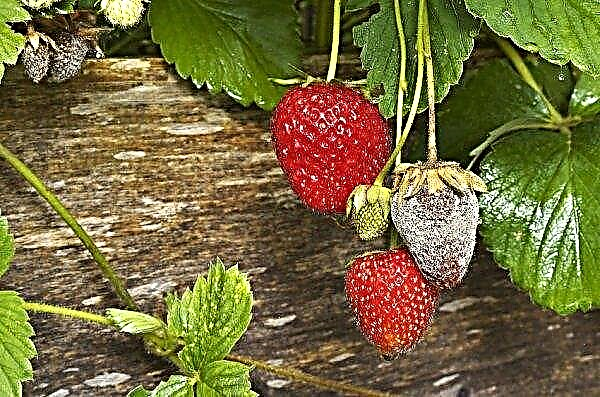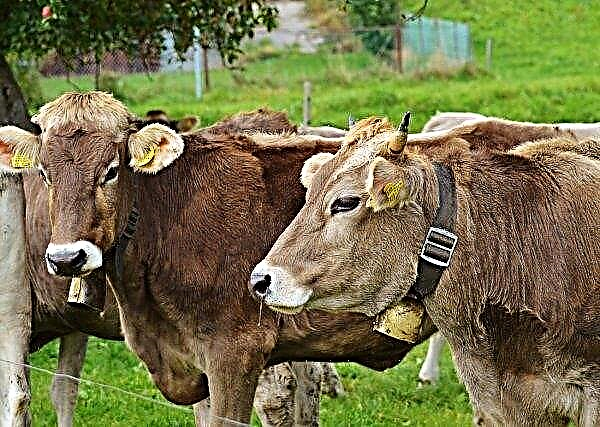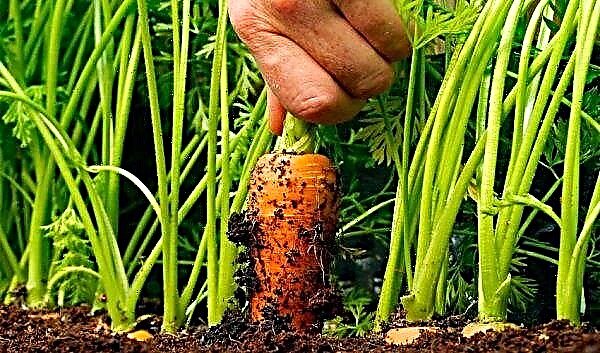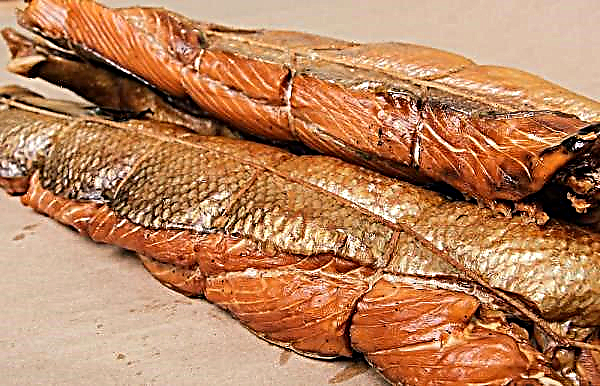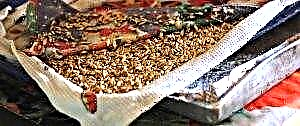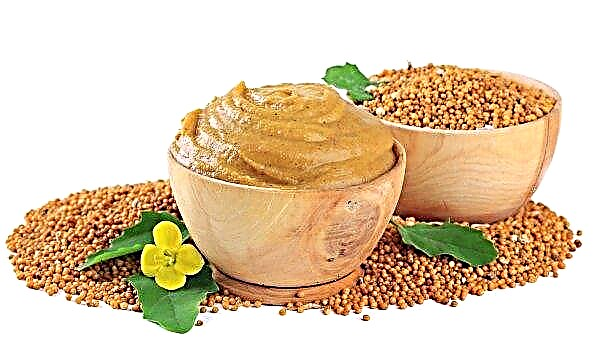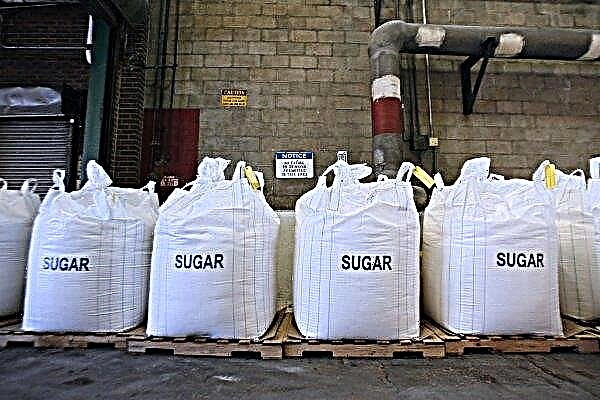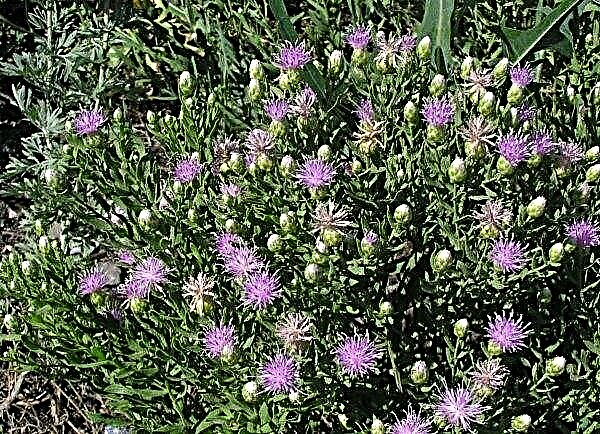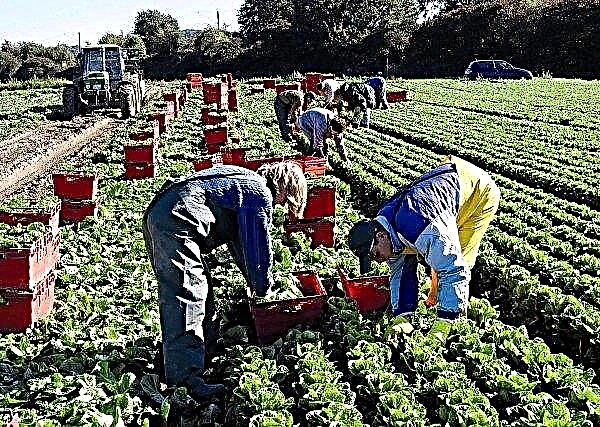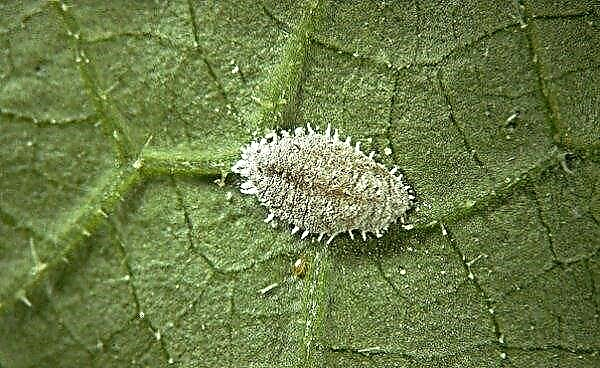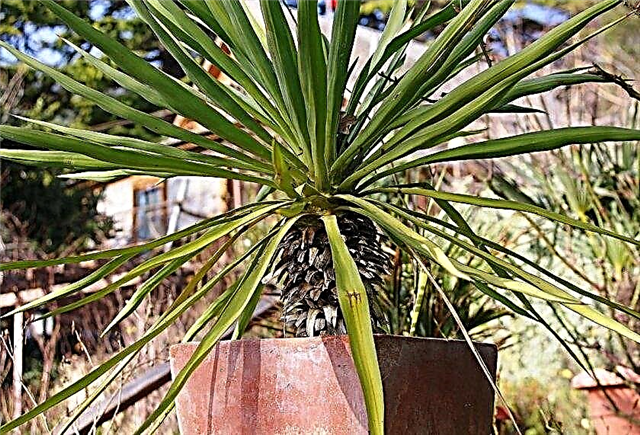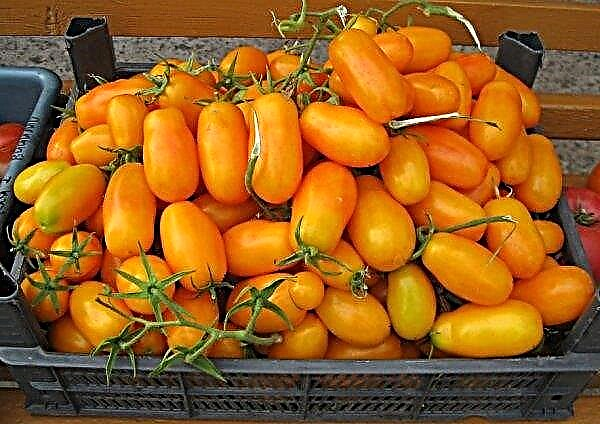One of the common varieties of onions for growing in the plots is Chalcedony onions. It perfectly tolerates long-term storage and does not lose its useful qualities and rich taste even after a long period of time. This article provides a description of this variety and its properties, conditions and methods for growing onions Chalcedony, and also lists the rules for caring for plants and methods of combating diseases and pests.
Description and characteristics of the variety
The Chalcedony variety was obtained by breeders of the Republic of Moldova and quickly gained popularity due to its attractive presentation and large head sizes.
Did you know? The Roman generals believed that the use of onions increases strength and courage, so he was necessarily included in the diet of soldiers.
The main characteristics of the variety Chalcedony:
- The variety belongs to early ripening, the crop can be harvested 110 days after planting.
- The size of the green part of the plants can reach 16 cm. The feathers of the onions are hollow inside, have juicy walls of moderate thickness and are painted in bright green color.
- The bulb is large and round, covered on the outside with a light brown smooth peel. The size of the bulb is about 15 cm in diameter.
- The pulp of the vegetable is white and very juicy. The scales are fleshy and arranged densely to each other.
- Productivity under good growing conditions can reach 7-8 kg per 1 m². The weight of one bulb is 130-150 g.
- The taste of feathers and onion heads Chalcedony is sweet-sharp, with moderate bitterness. The pulp has a mild onion flavor.
- This variety can be grown in a greenhouse and outdoors in temperate regions.
- Bulbs are characterized by good keeping quality; harvested crops can be stored for 8 months.
- Onions Chalcedony can germinate at low air temperatures (+3 ... + 5 ° C), is resistant to drought, common diseases and pest attacks.
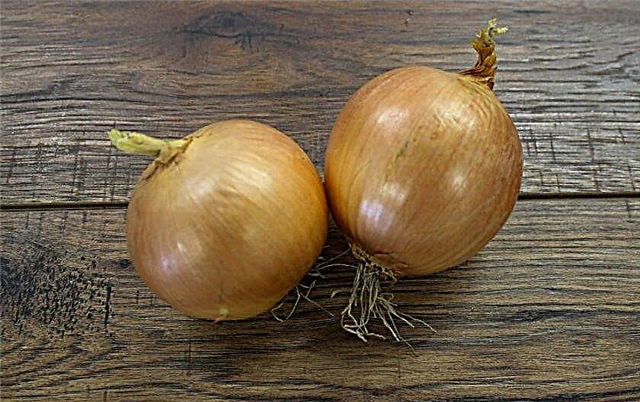
Properties of onions Chalcedony
In addition to the attractive presentation and large size of the bulbs, the Chalcedony variety also has other important properties for humans. Greens and vegetable heads have a useful vitamin composition, but in some cases they can cause harm to the body.
Benefit
Like other varieties, chalcedony onions are characterized by the presence in the pulp of fruits of vitamins B and C, calcium, zinc, iron, fluorine and manganese, as well as medicinal essential oils.
- Therefore, bulbs of this variety have such useful properties:
- stimulate metabolism and improve appetite;
- have a low calorie content, therefore, they can be included in the diet when losing weight;
- increase hemoglobin in the blood and help fight anemia;
- beneficial effect on the work of the cardiovascular system;
- cleanse the body of toxins and toxins;
- help to cope with depression and normalize sleep;
- increase the body's immunity against colds.
Possible harm and contraindications
Despite the long list of useful properties, when consumed in large quantities, onions Chalcedony can harm the body.
- Its negative qualities include:
- the appearance of an unpleasant odor from the oral cavity;
- increase in blood pressure;
- discomfort in the stomach;
- disturbances in the work of the heart;
- irritation of the mucous membranes of the upper respiratory tract, which can lead to an attack of suffocation.
It is strictly forbidden to use onions Chalcedony in such cases:
- stomach ulcer or gastritis;
- heart disease
- hypertension;
- asthma.
Important! Children can start giving onions only from the age of 8-9 months, adding it in small quantities to soups and vegetable stews.
Optimal time for landing
The timing of planting onions Chalcedony depends on the method of cultivation. Planting material is planted in open ground in spring or autumn, and in winter growing onions on a feather in a greenhouse, sowing is carried out in late autumn.
The optimal planting dates for this variety are listed below:
- planting seeds for seedlings can be done in late February or early March;
- grown seedlings are transplanted to the site in the second half of April;
- sowing seeds in open ground is carried out in early April;
- spring sowing in open soil is carried out at the end of March;
- landing of onion sets in open ground for the winter is carried out in the second half of October, 20-30 days before the onset of the first frost;
- planting seeds for winter onion cultivation on a feather in a greenhouse is carried out in late October.
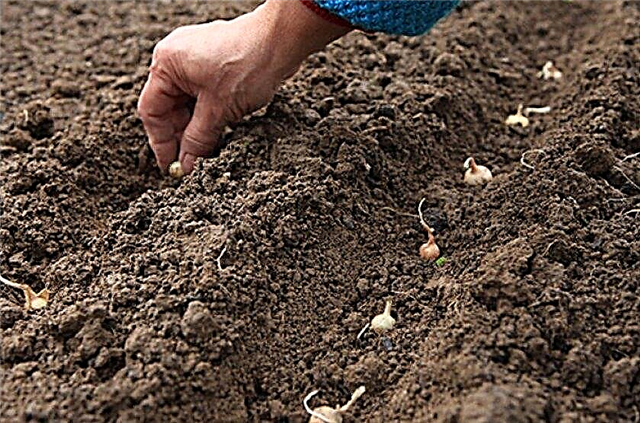
Growing Features
To get a generous onion crop from the site, you need to carefully study all the features of its cultivation. For the normal growth of onions, Chalcedony needs a properly selected place, as well as fertile and loose soil.
It is equally important to choose the appropriate method of growing varieties. It is selected taking into account the purpose for which the onion is grown - on a feather or to obtain a crop of large onions.
Growing conditions
Before planting onions, Chalcedony needs to choose a suitable site for it. For the successful cultivation of this variety, it is necessary to provide plants with comfortable conditions for growth, which include proper lighting, suitable air temperature and the optimal level of moisture in the soil.
The main requirements for growing onions Chalcedony are:
- beds with onions should be well lit by the sun - in the shade, planting material sprouts worse, and bulbs grow small and less tasty;
- choose a site that is protected from wind and drafts;
- Chalcedony onion can germinate in open ground even at + 3 ° C, but the optimum temperature for growing plants is +15 ... + 20 ° C;
- groundwater at the planting site should not be close to the surface, since this can lead to rotting of the bulbs in the ground;
- the onion bed should not be placed in places where melt or rain water has accumulated - such an abundance of moisture will ruin the entire crop.
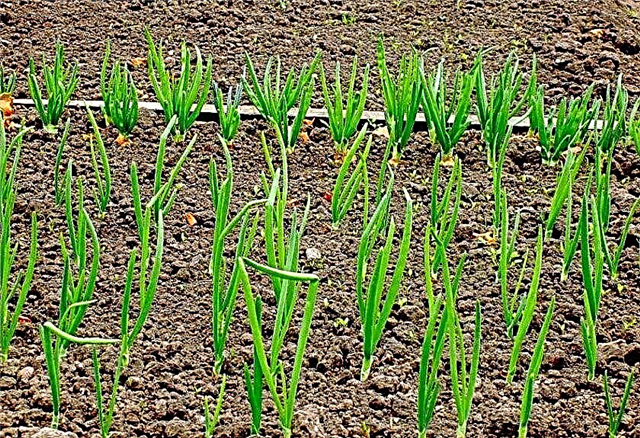
Soil and fertilizer
The root system of onions Chalcedony is very poorly developed, therefore, for its cultivation, it is necessary to select a site with loose and fertile soil. In terms of acidity, the soil should be slightly alkaline. To achieve this indicator of acid reaction, ash, lime and dolomite flour can be added to the soil.
The basic rules for preparing a site for planting Chalcedony are:
- in autumn, the land on the site is cleaned of residual greenery;
- 3 buckets of humus or compost are added to each unit of area, and then the earth is dug up so that the fertilizers are evenly distributed in the soil;
- in the spring after snow melt, 3 buckets of humus, 30 g of superphosphate and 1 glass of ash per 1 m² of area are brought in, and then the ground is dug up again;
- remove the roots of weeds and loosen the surface of the soil, breaking up large clods of earth;
- for planting onions in open ground, they form a high bed about 20 cm high, so that the earth is better warmed by the sun, let water and air pass through;
- 2-3 days before the direct planting of the onion, the bed is watered if necessary and covered with a film so that it warms up better.
Important! Light loams or sandy loam soil of increased fertility are best suited for growing this variety.
Cultivation methods
Chalcedony variety can be grown through seedlings or by planting planting material directly in the open ground.
The main methods of growing this variety include:
- planting seeds for growing seedlings - It is used to produce greens and large onion heads in one year;
- open ground planting - It is used to obtain a crop of fresh herbs and large, full onions;
- use of a two year cycle growing onions in the open ground to obtain a full crop of greens and bulbs from seeds;
- sowing seeds in a greenhouse for growing onions on greens in the winter.
Planting seeds through seedlings
One of the methods for growing this variety of onions is to plant seeds to obtain seedlings with further planting of young sprouts on an open bed. For this, you can use both purchased planting material, and independently harvested seeds. For planting, seeds of the same size are selected, having a beautiful appearance.
Planting seeds for growing seedlings is recommended to start in March. In open ground, seeds can be planted only in mid-April, so that the soil has time to warm up. Step-by-step instructions for planting seeds and growing seedlings:
Step-by-step instructions for planting seeds and growing seedlings:
- Soak the planting material in a solution of potassium permanganate for 20-30 minutes to disinfect.
- Place the seeds in a container of warm water for better germination. Then let them dry and treat with growth stimulants.
- Place a layer of gauze on a saucer and spread the seeds on it. Cover them with a second layer of gauze and moisten it well. Keep the seeds on a saucer for 5-6 days, regularly moistening the cheesecloth with warm water.
- Prepare a plastic container with cells and fill it with fertile loose soil, consisting of equal parts of peat, sand and earth from the site.
- Place 3-4 seeds in each cell, deepening them into the ground by 0.5 cm. Sprinkle them with a small amount of soil.
- Water the planted seeds slightly with water and cover the container with foil. Put the container in a sunny and warm place (+22 ... + 25 ° С). Periodically raise the film for watering the soil and airing. Shoots appear about a week after planting.
- After seed germination, remove the film and rearrange the container in a well-lit place with an air temperature of +16 ... + 18 ° C during the day and about + 12 ° C at night. There should not be a draft near the shoots.
- With insufficient duration of natural daylight, seedlings are placed under the lamp. Sprouts should receive natural or artificial light for at least 14–16 hours a day.
- Watering seedlings is carried out as the topsoil is dried with a moderate amount of warm water.
- Every 14 days, the sprouts are fed with a solution of mullein or bird droppings, bringing it along with watering.
- In April, seedlings begin to harden, exposing the container to the balcony. First, the sprouts are carried out for 30–40 minutes, gradually increasing the time spent on the balcony.
- Planting seedlings in open ground is carried out at the end of April according to the 25 × 25 pattern. The age of the shoots at the time of transplantation should be at least 60 days.
- Onion sprouts are carefully removed from the container and placed in a prepared hole to a depth of 3 cm, leaning them against the wall of the recess. Then a handful of compost is placed in each well and the sprouts are lightly sprinkled with earth.
- Lightly water the planted seedlings with warm water and mulch the soil around the plants with peat.
Sevkom landing
This method of cultivation is the most common, because it requires minimal time and labor, and also allows you to get a crop of bulbs in a short time after planting. Onion sets used for planting can immediately be planted in open ground.
Video: Chalcedony onion sowing harvest
Step-by-step algorithm for planting onions Chalcedony sevkom:
- Sort planting material, selecting healthy and beautiful bulbs of the same size for planting.
- The seeds are heated in the oven at a temperature of + 40 ° C for 10 hours, and then soaked in a warm solution of fungicide to destroy pathogenic bacteria. After soaking, the planting material should be slightly washed with water and dried.
- If the planting is carried out in spring, then the upper ends of the bulbs are cut off, leaving a tail about 3 cm in size.
- On the bed make longitudinal furrows 3-4 cm deep. Between adjacent rows leave 20-25 cm.
- At the bottom of the furrow lay the sowing, placing it bottom-down. The distance between adjacent bulbs should be at least 6 cm.
- Sprinkle a furrow with sevka planted with earth and level its surface with your hands. If the soil is too dry, you can slightly pour it with warm water.
- If planting is carried out before winter, the bed with planting material is mulched with a thick layer of dry straw or fallen foliage.
Two year onion cultivation
Some gardeners prefer to grow chalcedony onions for two years, planting seeds in open ground for growing seed, which is then used as planting material for the next year.
Step by step instructions for growing onions in this way:Important! For the autumn planting, use the smallest onion set (less than 1 cm in diameter) so that it does not have time to germinate before frost.
- Seeds are soaked for half an hour in a solution of potassium permanganate for disinfection, and then treated with growth stimulants.
- Place the planting material between two layers of wet gauze and put it in a warm place with good lighting. Gauze is periodically sprayed with water to keep it moist. Germinate seeds in this way for 5-6 days.
- On prepared beds make longitudinal furrows with a depth of 2-3 cm, placing them at a distance of 20-25 cm from each other. At the bottom of the furrow, you need to pour a little white river sand.
- Prepared seeds are placed in the furrow, placing them at a distance of 2-3 cm from each other. Then sprinkle the seeds with loose earth.
- If the soil on the site is too dry, then carry out its irrigation with a small amount of warm water.
- After the appearance of green shoots, they are treated accordingly, the rules of which are described later in the article.
- In the second half of August, the green part of the plants begins to turn yellow, and the formation of small bulbs is completed in the ground. The resulting sevoc is harvested and further planted according to the rules listed in the previous paragraph. A year later, plants with large bulbs suitable for eating are obtained from the seeds.
Video: Biennial Chalcedony Growing
Sowing seeds on a feather
To get fresh herbs in the winter, you can plant Chalcedony onions in a heated greenhouse, starting in late October. Sowing seeds is carried out in small wooden boxes with fertile soil. The technology for preparing and planting seeds is the same as when growing seedlings.
After the emergence of seedlings, the care of plants in the greenhouse is carried out according to the following rules:
- the air temperature in the greenhouse should be +16 ... + 18 ° C;
- watering is carried out with a small amount of warm water 1-2 times a week as the soil dries up;
- with a lack of natural light, plants are placed under fluorescent lamps so that the total daylight hours are at least 12 hours;
- the soil around the plants must be cleaned of weeds and loosened to a depth of 2-3 cm;
- with a slow growth of greenery, humus or wood ash can be applied as fertilizer.

Variety Care Features
Regardless of the method of cultivation, growing plants need to provide appropriate care. Onions Chalcedony needs a sufficient amount of moisture and regular feeding, which will contribute to the growth of the feather and the formation of large bulbs. It is equally important to care for the soil around the plants in order to improve the quality of the crop, as well as prevent the emergence of diseases and pests.
Watering and feeding
During the period of active growth of green mass and the formation of bulbs, plants need a lot of water, but waterlogging of the soil should be avoided to prevent decay of plants and the development of fungal diseases.
Did you know? The image of the bulb is on the walls of the oldest memorial of history - the tomb of Tutankhamun. It was made in 1352 BC. e.
The main recommendations for watering plants are listed below:
- in May and June, Chalcedony onions should be watered with a small amount of water as the topsoil dries up;
- only warm water is used for irrigation, which was previously poured into the tank and left for warming in the sun;
- watering is carried out by a drop method from a watering can. Perform this procedure carefully so as not to break the leaves of plants;
- Since the second half of July, plants are not watered, because at this time the formation of bulbs begins and excess moisture can cause them to rot.
In order for the plants to form large and beautiful bulbs, you need to feed them with fertilizers:
- when the height of young sprouts reaches 10 cm, top dressing is made from complex mineral fertilizers or mullein diluted with water in a ratio of 1:10;
- after 3 weeks, a second top dressing is introduced, consisting of superphosphate, potassium fertilizers and urea;
- in the second half of summer, onions Chalcedony does not need fertilizers.
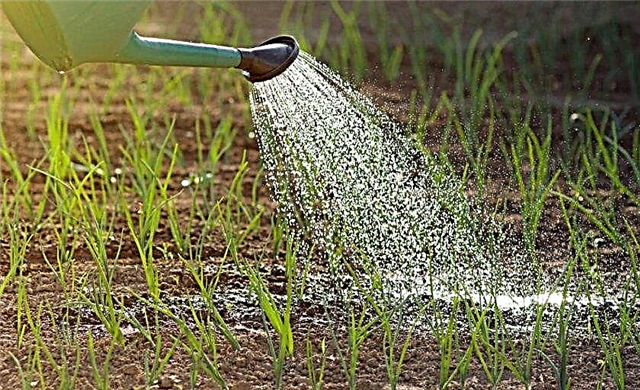
Soil loosening
For the weak root system of the onion, Chalcedony needs loose soil. It is not only better warmed up by the sun and absorbs moisture well, but also provides air to the roots of the plant. The procedure of loosening the soil in the beds with onions is carried out if a dense crust appears on the upper layer of the earth. Loosen the soil around the plants to a depth of 2-3 cm, being careful not to damage the roots of the bulbs.
Weeding
So that fast-growing weeds do not create a shadow for young onion sprouts, it is necessary to regularly weed the aisles.
The basic rules for weeding beds are listed below:
- weeds must be removed immediately after their appearance, i.e. when pulling out large weeds, the onion heads can move and the plants will stop growing;
- pull out the weeds with your hands so as not to damage the onion sprouts;
- weeding is best done after watering the beds so that the weed grass is more easily removed along with the roots;
- after removing weeds, it is recommended to slightly loosen the soil;
- all plant debris must be collected and taken out of the site to prevent the appearance of diseases and pests.

Diseases and Pests
With proper care, onions Chalcedony has a stable immunity to diseases and pests. But in case of violation of the irrigation regime or improper cultivation of the soil, plants may show signs of infection, as a result of which there is a risk of losing a significant part of the crop.
Important! Use insecticides to combat diseases and pests of onions is necessary only as a last resort, because chemicals can accumulate in greens and fruits.
The main diseases and pests of this variety:
- Onion moth. The butterfly lays eggs on the leaves of plants, from which larvae appear. They bite into the flesh of onion leaves and suck out the juice from them; the tips of the leaves begin to dry out, light spots appear on them. To combat the pest, plants need to be treated with a decoction of potato or tomato tops (4 kg of leaves per 10 liters of water). For prevention, carrots, mustard or calendula are planted next to the onion, the smell of which repels butterflies.
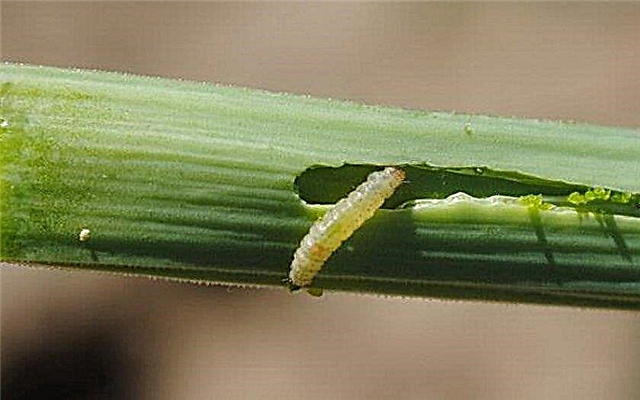
- Onion fly. This pest lays eggs in the soil near the onion, and white larvae emerging from them damage the bulb. The plant stops growing, the leaves turn yellow quickly, the bulbs become soft and loose to the touch. You can destroy the pest by watering the affected plants with a chilled tincture of 10 l of boiling water, 180 g of tobacco leaves and a handful of grated laundry soap. For prevention, it is necessary to dig the site before planting, as well as to carry out the disinfection of planting material.
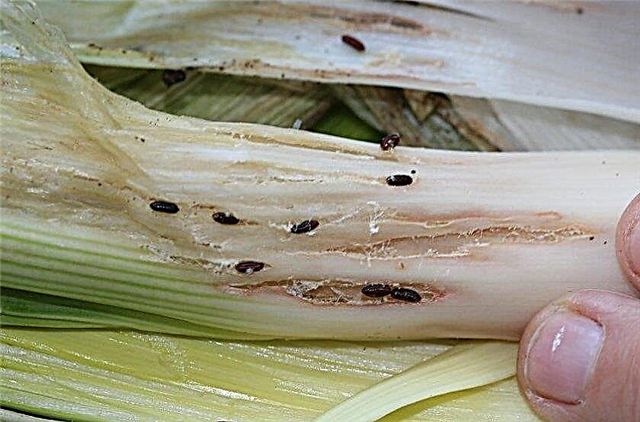
- Stem nematode. The pest is a tiny worm living in the topsoil. It damages the bulbs and leads to a slowdown in plant growth, cracking and softening of the heads. You can cope with the pest using saline solution (400 g per bucket of water) by watering the beds with it. For prophylaxis, seeds and seeds are disinfected and thoroughly removed from the soil before planting.
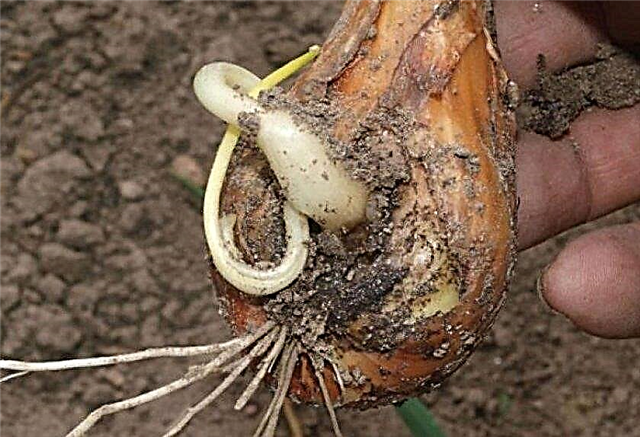
- Rotting the neck of the onion. The causes of the disease are excessive watering and thickened plantings. Affected plants lag behind in growth, brown spots appear on the bulb, it rots. To combat the disease, the soil around the plants is sprinkled with chalk, and specimens damaged by rot are dug up and burned. For prevention, it is recommended to moderate watering and thin out too thickened onion plantings.
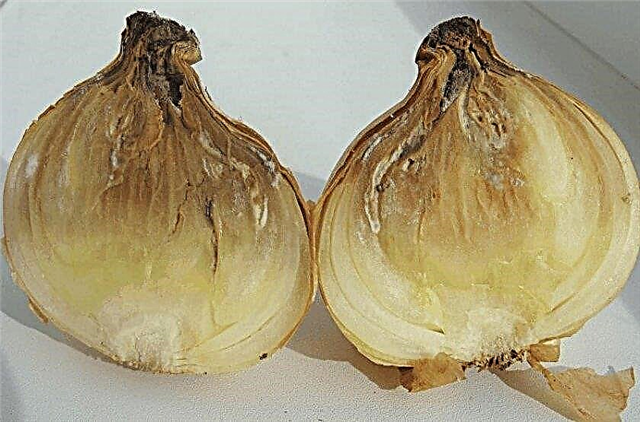
- Peronosporosis (downy mildew). The disease occurs in conditions of high humidity and growing in the shade. Green spots appear on the leaves of the onion, which eventually turn gray. Diseased plants are dug up and burned, and the beds are sprayed with fungicides. To prevent the occurrence of peronosporosis, you need to plant onions in a well-lit area and follow the recommended planting scheme.
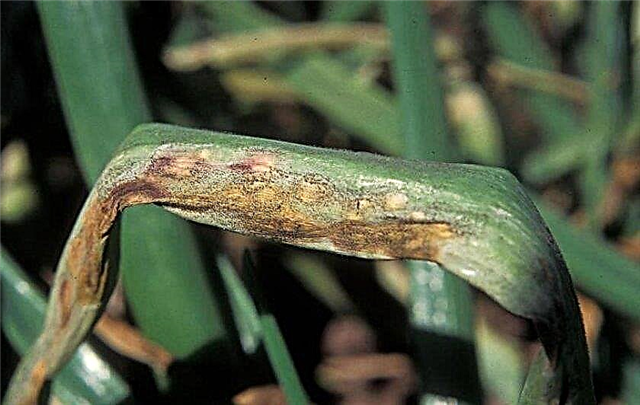
Harvesting and storage
Chalcedony bulbs are harvested between mid-August and mid-September. Yellowing leaves, which begin to lie on the ground, testify to the ripening of the vegetable. The bulbs turn light brown and no longer increase in size.
The basic rules for harvesting and storage of crops are listed below:
- Head cleaning should be done in dry, sunny weather.
- Bulbs are carefully dug up with a pitchfork and pulled out of the ground by the leaves, clearing them with their hands from the ground.
- Vegetables are laid out in the sun to dry, which lasts 1.5–2 weeks. At night and in the rain they are hidden under a canopy.
- Then the onions are sorted, selecting damaged specimens, the upper leaves are cut at a distance of 5-6 cm from the bulb.
- Bulbs are stored in wooden crates at air temperatures from +5 to + 20 ° C in a well-ventilated and darkened room.
Did you know? Onions got its name due to the external similarity of the head with turnips.
Useful Tips
Experienced gardeners highlight several additional recommendations that also help to get a generous crop of Chalcedony onions.
A list of these recommendations is presented below:
- zucchini, pumpkin and cucumbers are good precursors for onions;
- it is not recommended to plant onions in the area where carrots, radishes or celery were grown last year;
- it is not recommended to use fresh manure as fertilizer, because it will provoke the growth of green mass, but will make the bulb small;
- for growing seedlings, you can use the fertile land purchased in a specialized store;
- if after planting seedlings in open ground night frosts are observed, the sprouts need to be covered with a film;
- reuse the site for planting onions is possible only after 3-4 years;
- if the plants in the row are too close to each other, they must be thinned out to provide free space for the formation of large bulbs;
- To repel insect pests, you can plant marigolds, calendula or mustard along the perimeter of the bed.
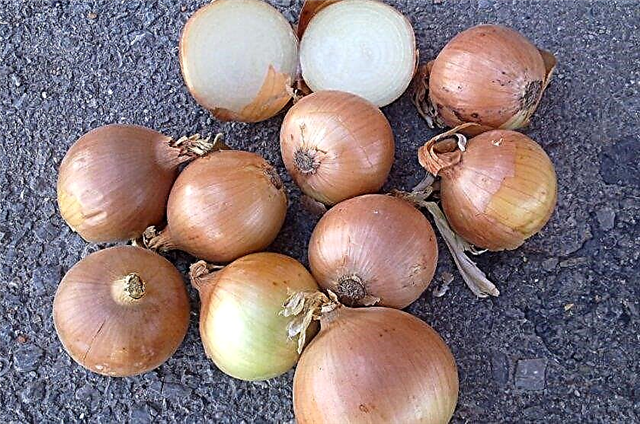
Onions Chalcedony is a universal variety that can be grown to produce fresh herbs and large juicy bulbs. Using the growing recommendations and plant care rules listed in this article, you can achieve a high yield of beautiful and tasty vegetables.












